Accounting: Qualitative Characteristics and Normative Theories
VerifiedAdded on 2020/03/16
|12
|3313
|49
Report
AI Summary
This report delves into normative theories in accounting, exploring the conceptual framework and its significance. It examines the qualitative characteristics of accounting information, emphasizing relevance, reliability, understandability, and comparability. The report then analyzes historical cost accounting and its limitations, presenting alternative normative theories such as Current Purchasing Power Accounting (CPPA), Current Cost Accounting (CCA), Continuously Contemporary Accounting (CoCoA), Fair Value Accounting (FVA), and Modified Historical Cost Accounting (MHCA). Furthermore, it discusses the building blocks of the conceptual framework of accounting, including financial reporting definition, reporting entity, objectives of financial reporting, qualitative characteristics, financial statement elements, and measurement basis. The report highlights the advantages of accounting and the importance of the conceptual framework for standard-setting and financial reporting.
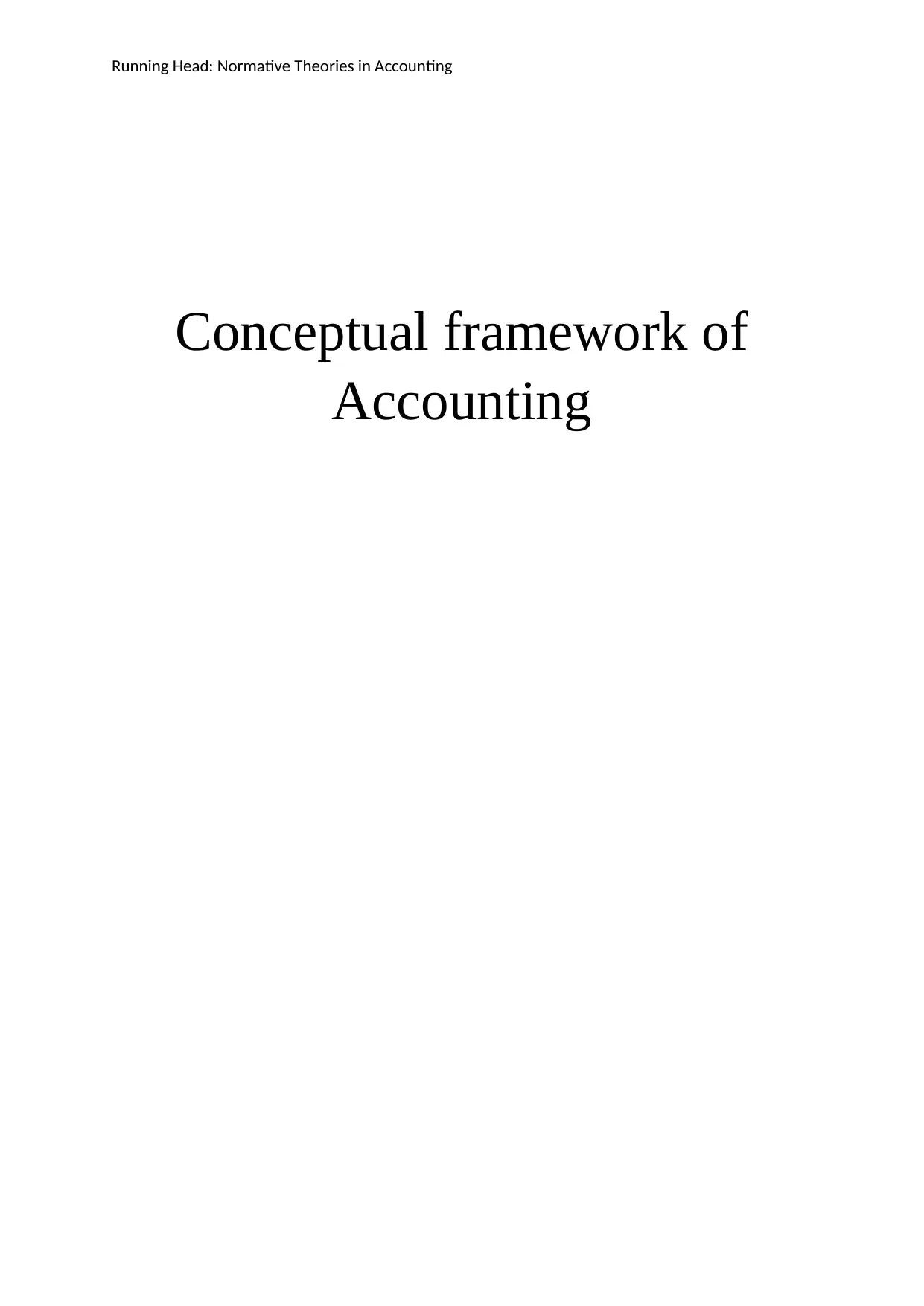
Running Head: Normative Theories in Accounting
Conceptual framework of
Accounting
Conceptual framework of
Accounting
Paraphrase This Document
Need a fresh take? Get an instant paraphrase of this document with our AI Paraphraser
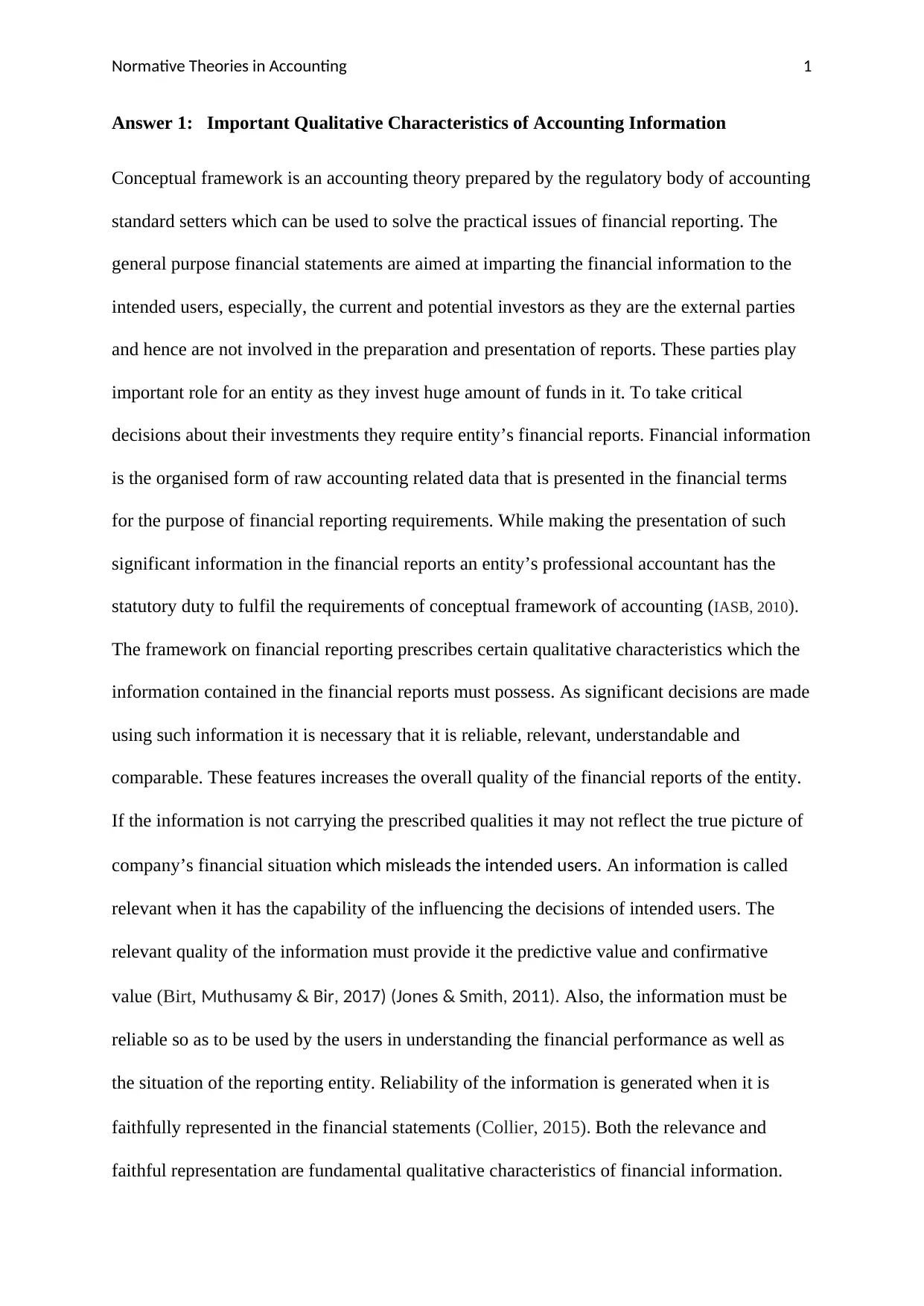
Normative Theories in Accounting 1
Answer 1: Important Qualitative Characteristics of Accounting Information
Conceptual framework is an accounting theory prepared by the regulatory body of accounting
standard setters which can be used to solve the practical issues of financial reporting. The
general purpose financial statements are aimed at imparting the financial information to the
intended users, especially, the current and potential investors as they are the external parties
and hence are not involved in the preparation and presentation of reports. These parties play
important role for an entity as they invest huge amount of funds in it. To take critical
decisions about their investments they require entity’s financial reports. Financial information
is the organised form of raw accounting related data that is presented in the financial terms
for the purpose of financial reporting requirements. While making the presentation of such
significant information in the financial reports an entity’s professional accountant has the
statutory duty to fulfil the requirements of conceptual framework of accounting (IASB, 2010).
The framework on financial reporting prescribes certain qualitative characteristics which the
information contained in the financial reports must possess. As significant decisions are made
using such information it is necessary that it is reliable, relevant, understandable and
comparable. These features increases the overall quality of the financial reports of the entity.
If the information is not carrying the prescribed qualities it may not reflect the true picture of
company’s financial situation which misleads the intended users. An information is called
relevant when it has the capability of the influencing the decisions of intended users. The
relevant quality of the information must provide it the predictive value and confirmative
value (Birt, Muthusamy & Bir, 2017) (Jones & Smith, 2011). Also, the information must be
reliable so as to be used by the users in understanding the financial performance as well as
the situation of the reporting entity. Reliability of the information is generated when it is
faithfully represented in the financial statements (Collier, 2015). Both the relevance and
faithful representation are fundamental qualitative characteristics of financial information.
Answer 1: Important Qualitative Characteristics of Accounting Information
Conceptual framework is an accounting theory prepared by the regulatory body of accounting
standard setters which can be used to solve the practical issues of financial reporting. The
general purpose financial statements are aimed at imparting the financial information to the
intended users, especially, the current and potential investors as they are the external parties
and hence are not involved in the preparation and presentation of reports. These parties play
important role for an entity as they invest huge amount of funds in it. To take critical
decisions about their investments they require entity’s financial reports. Financial information
is the organised form of raw accounting related data that is presented in the financial terms
for the purpose of financial reporting requirements. While making the presentation of such
significant information in the financial reports an entity’s professional accountant has the
statutory duty to fulfil the requirements of conceptual framework of accounting (IASB, 2010).
The framework on financial reporting prescribes certain qualitative characteristics which the
information contained in the financial reports must possess. As significant decisions are made
using such information it is necessary that it is reliable, relevant, understandable and
comparable. These features increases the overall quality of the financial reports of the entity.
If the information is not carrying the prescribed qualities it may not reflect the true picture of
company’s financial situation which misleads the intended users. An information is called
relevant when it has the capability of the influencing the decisions of intended users. The
relevant quality of the information must provide it the predictive value and confirmative
value (Birt, Muthusamy & Bir, 2017) (Jones & Smith, 2011). Also, the information must be
reliable so as to be used by the users in understanding the financial performance as well as
the situation of the reporting entity. Reliability of the information is generated when it is
faithfully represented in the financial statements (Collier, 2015). Both the relevance and
faithful representation are fundamental qualitative characteristics of financial information.
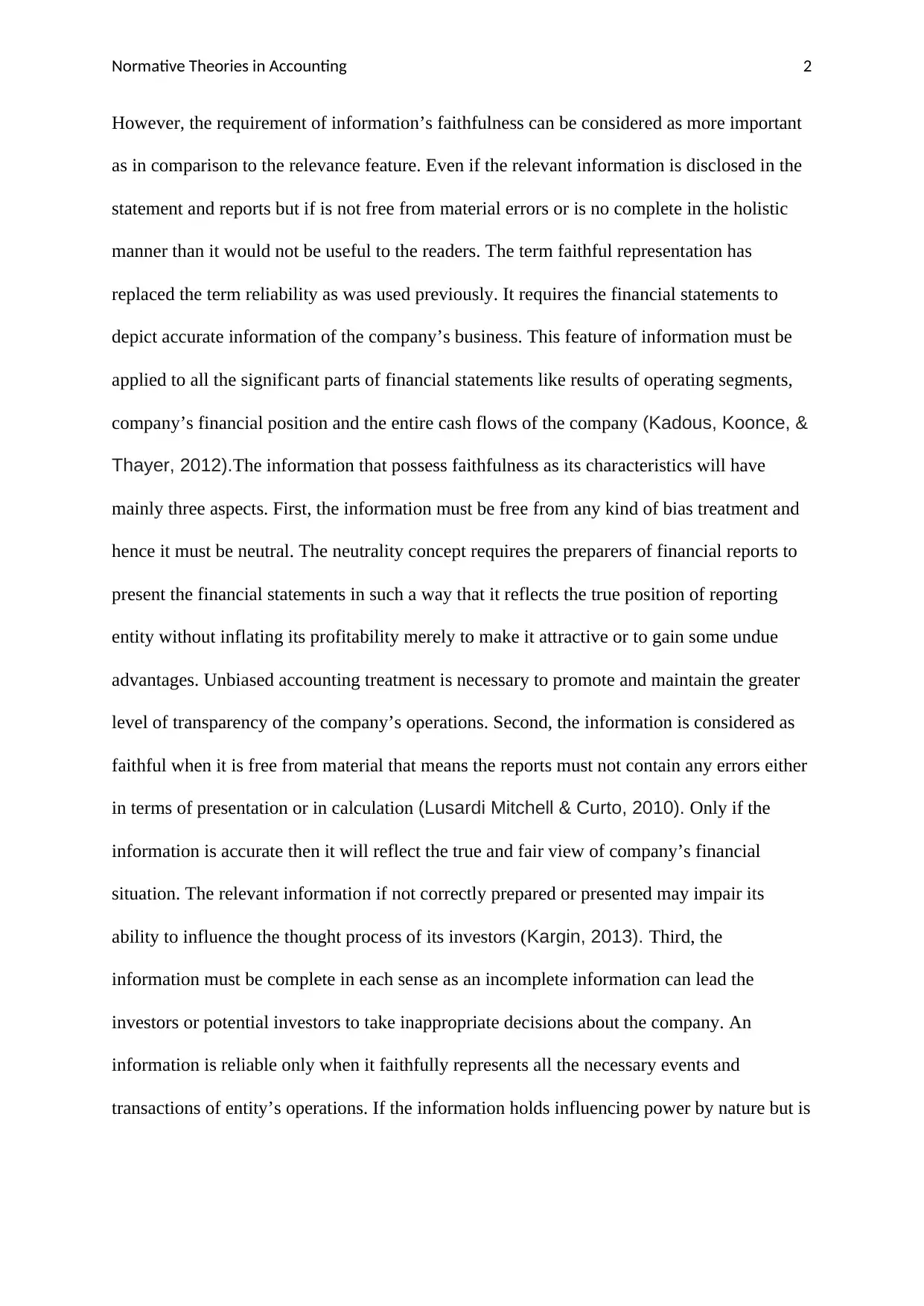
Normative Theories in Accounting 2
However, the requirement of information’s faithfulness can be considered as more important
as in comparison to the relevance feature. Even if the relevant information is disclosed in the
statement and reports but if is not free from material errors or is no complete in the holistic
manner than it would not be useful to the readers. The term faithful representation has
replaced the term reliability as was used previously. It requires the financial statements to
depict accurate information of the company’s business. This feature of information must be
applied to all the significant parts of financial statements like results of operating segments,
company’s financial position and the entire cash flows of the company (Kadous, Koonce, &
Thayer, 2012).The information that possess faithfulness as its characteristics will have
mainly three aspects. First, the information must be free from any kind of bias treatment and
hence it must be neutral. The neutrality concept requires the preparers of financial reports to
present the financial statements in such a way that it reflects the true position of reporting
entity without inflating its profitability merely to make it attractive or to gain some undue
advantages. Unbiased accounting treatment is necessary to promote and maintain the greater
level of transparency of the company’s operations. Second, the information is considered as
faithful when it is free from material that means the reports must not contain any errors either
in terms of presentation or in calculation (Lusardi Mitchell & Curto, 2010). Only if the
information is accurate then it will reflect the true and fair view of company’s financial
situation. The relevant information if not correctly prepared or presented may impair its
ability to influence the thought process of its investors (Kargin, 2013). Third, the
information must be complete in each sense as an incomplete information can lead the
investors or potential investors to take inappropriate decisions about the company. An
information is reliable only when it faithfully represents all the necessary events and
transactions of entity’s operations. If the information holds influencing power by nature but is
However, the requirement of information’s faithfulness can be considered as more important
as in comparison to the relevance feature. Even if the relevant information is disclosed in the
statement and reports but if is not free from material errors or is no complete in the holistic
manner than it would not be useful to the readers. The term faithful representation has
replaced the term reliability as was used previously. It requires the financial statements to
depict accurate information of the company’s business. This feature of information must be
applied to all the significant parts of financial statements like results of operating segments,
company’s financial position and the entire cash flows of the company (Kadous, Koonce, &
Thayer, 2012).The information that possess faithfulness as its characteristics will have
mainly three aspects. First, the information must be free from any kind of bias treatment and
hence it must be neutral. The neutrality concept requires the preparers of financial reports to
present the financial statements in such a way that it reflects the true position of reporting
entity without inflating its profitability merely to make it attractive or to gain some undue
advantages. Unbiased accounting treatment is necessary to promote and maintain the greater
level of transparency of the company’s operations. Second, the information is considered as
faithful when it is free from material that means the reports must not contain any errors either
in terms of presentation or in calculation (Lusardi Mitchell & Curto, 2010). Only if the
information is accurate then it will reflect the true and fair view of company’s financial
situation. The relevant information if not correctly prepared or presented may impair its
ability to influence the thought process of its investors (Kargin, 2013). Third, the
information must be complete in each sense as an incomplete information can lead the
investors or potential investors to take inappropriate decisions about the company. An
information is reliable only when it faithfully represents all the necessary events and
transactions of entity’s operations. If the information holds influencing power by nature but is
⊘ This is a preview!⊘
Do you want full access?
Subscribe today to unlock all pages.

Trusted by 1+ million students worldwide
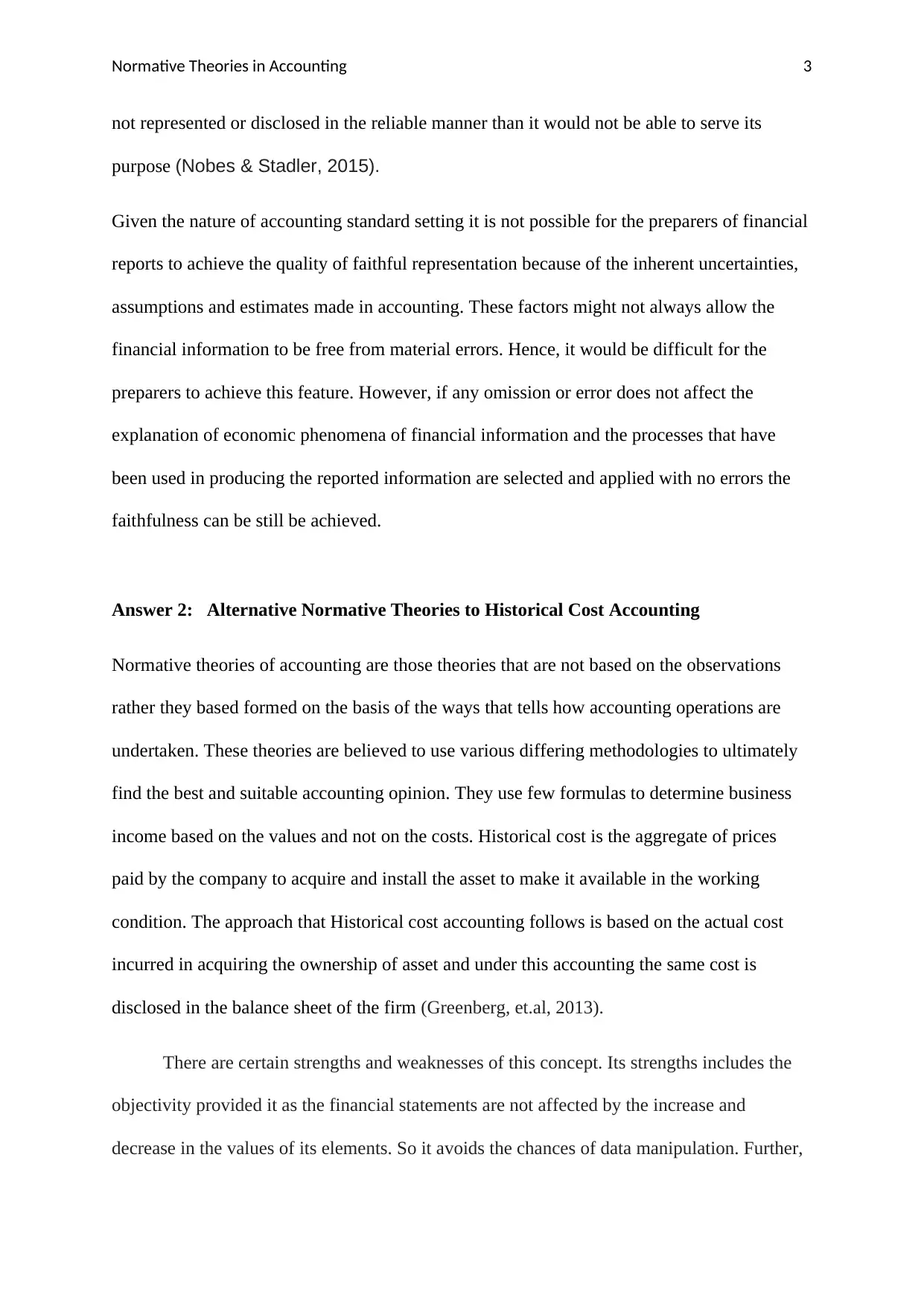
Normative Theories in Accounting 3
not represented or disclosed in the reliable manner than it would not be able to serve its
purpose (Nobes & Stadler, 2015).
Given the nature of accounting standard setting it is not possible for the preparers of financial
reports to achieve the quality of faithful representation because of the inherent uncertainties,
assumptions and estimates made in accounting. These factors might not always allow the
financial information to be free from material errors. Hence, it would be difficult for the
preparers to achieve this feature. However, if any omission or error does not affect the
explanation of economic phenomena of financial information and the processes that have
been used in producing the reported information are selected and applied with no errors the
faithfulness can be still be achieved.
Answer 2: Alternative Normative Theories to Historical Cost Accounting
Normative theories of accounting are those theories that are not based on the observations
rather they based formed on the basis of the ways that tells how accounting operations are
undertaken. These theories are believed to use various differing methodologies to ultimately
find the best and suitable accounting opinion. They use few formulas to determine business
income based on the values and not on the costs. Historical cost is the aggregate of prices
paid by the company to acquire and install the asset to make it available in the working
condition. The approach that Historical cost accounting follows is based on the actual cost
incurred in acquiring the ownership of asset and under this accounting the same cost is
disclosed in the balance sheet of the firm (Greenberg, et.al, 2013).
There are certain strengths and weaknesses of this concept. Its strengths includes the
objectivity provided it as the financial statements are not affected by the increase and
decrease in the values of its elements. So it avoids the chances of data manipulation. Further,
not represented or disclosed in the reliable manner than it would not be able to serve its
purpose (Nobes & Stadler, 2015).
Given the nature of accounting standard setting it is not possible for the preparers of financial
reports to achieve the quality of faithful representation because of the inherent uncertainties,
assumptions and estimates made in accounting. These factors might not always allow the
financial information to be free from material errors. Hence, it would be difficult for the
preparers to achieve this feature. However, if any omission or error does not affect the
explanation of economic phenomena of financial information and the processes that have
been used in producing the reported information are selected and applied with no errors the
faithfulness can be still be achieved.
Answer 2: Alternative Normative Theories to Historical Cost Accounting
Normative theories of accounting are those theories that are not based on the observations
rather they based formed on the basis of the ways that tells how accounting operations are
undertaken. These theories are believed to use various differing methodologies to ultimately
find the best and suitable accounting opinion. They use few formulas to determine business
income based on the values and not on the costs. Historical cost is the aggregate of prices
paid by the company to acquire and install the asset to make it available in the working
condition. The approach that Historical cost accounting follows is based on the actual cost
incurred in acquiring the ownership of asset and under this accounting the same cost is
disclosed in the balance sheet of the firm (Greenberg, et.al, 2013).
There are certain strengths and weaknesses of this concept. Its strengths includes the
objectivity provided it as the financial statements are not affected by the increase and
decrease in the values of its elements. So it avoids the chances of data manipulation. Further,
Paraphrase This Document
Need a fresh take? Get an instant paraphrase of this document with our AI Paraphraser
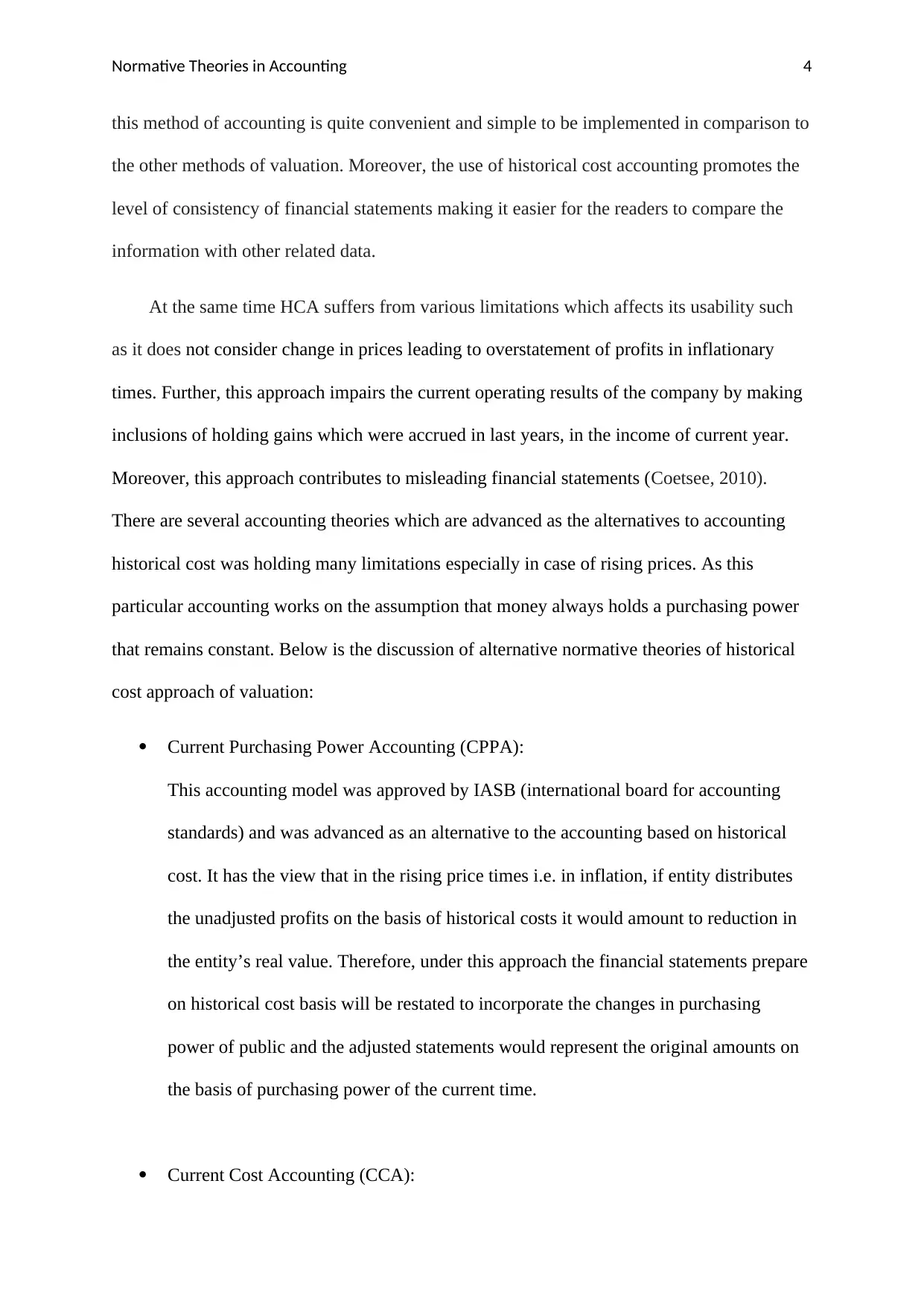
Normative Theories in Accounting 4
this method of accounting is quite convenient and simple to be implemented in comparison to
the other methods of valuation. Moreover, the use of historical cost accounting promotes the
level of consistency of financial statements making it easier for the readers to compare the
information with other related data.
At the same time HCA suffers from various limitations which affects its usability such
as it does not consider change in prices leading to overstatement of profits in inflationary
times. Further, this approach impairs the current operating results of the company by making
inclusions of holding gains which were accrued in last years, in the income of current year.
Moreover, this approach contributes to misleading financial statements (Coetsee, 2010).
There are several accounting theories which are advanced as the alternatives to accounting
historical cost was holding many limitations especially in case of rising prices. As this
particular accounting works on the assumption that money always holds a purchasing power
that remains constant. Below is the discussion of alternative normative theories of historical
cost approach of valuation:
Current Purchasing Power Accounting (CPPA):
This accounting model was approved by IASB (international board for accounting
standards) and was advanced as an alternative to the accounting based on historical
cost. It has the view that in the rising price times i.e. in inflation, if entity distributes
the unadjusted profits on the basis of historical costs it would amount to reduction in
the entity’s real value. Therefore, under this approach the financial statements prepare
on historical cost basis will be restated to incorporate the changes in purchasing
power of public and the adjusted statements would represent the original amounts on
the basis of purchasing power of the current time.
Current Cost Accounting (CCA):
this method of accounting is quite convenient and simple to be implemented in comparison to
the other methods of valuation. Moreover, the use of historical cost accounting promotes the
level of consistency of financial statements making it easier for the readers to compare the
information with other related data.
At the same time HCA suffers from various limitations which affects its usability such
as it does not consider change in prices leading to overstatement of profits in inflationary
times. Further, this approach impairs the current operating results of the company by making
inclusions of holding gains which were accrued in last years, in the income of current year.
Moreover, this approach contributes to misleading financial statements (Coetsee, 2010).
There are several accounting theories which are advanced as the alternatives to accounting
historical cost was holding many limitations especially in case of rising prices. As this
particular accounting works on the assumption that money always holds a purchasing power
that remains constant. Below is the discussion of alternative normative theories of historical
cost approach of valuation:
Current Purchasing Power Accounting (CPPA):
This accounting model was approved by IASB (international board for accounting
standards) and was advanced as an alternative to the accounting based on historical
cost. It has the view that in the rising price times i.e. in inflation, if entity distributes
the unadjusted profits on the basis of historical costs it would amount to reduction in
the entity’s real value. Therefore, under this approach the financial statements prepare
on historical cost basis will be restated to incorporate the changes in purchasing
power of public and the adjusted statements would represent the original amounts on
the basis of purchasing power of the current time.
Current Cost Accounting (CCA):
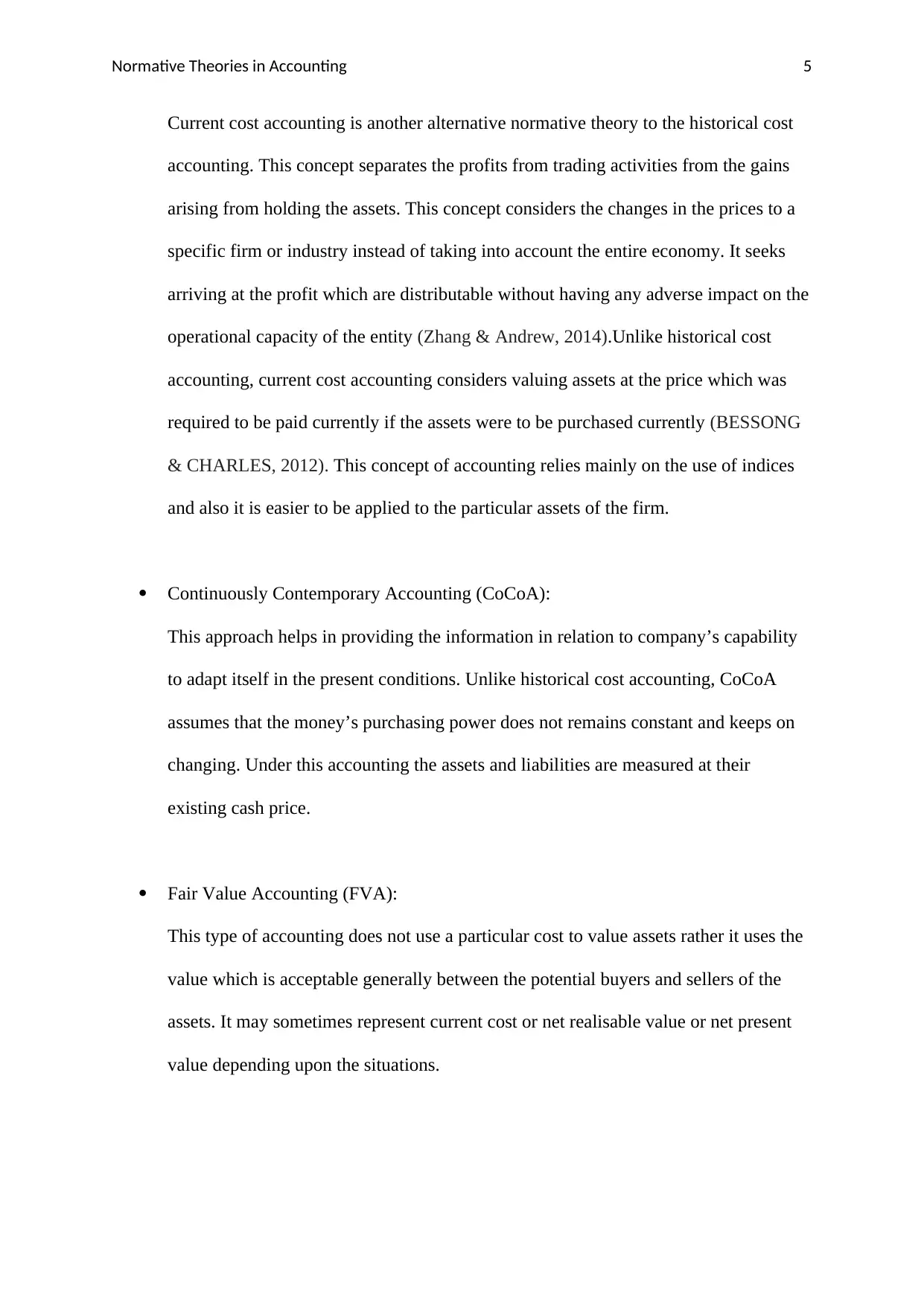
Normative Theories in Accounting 5
Current cost accounting is another alternative normative theory to the historical cost
accounting. This concept separates the profits from trading activities from the gains
arising from holding the assets. This concept considers the changes in the prices to a
specific firm or industry instead of taking into account the entire economy. It seeks
arriving at the profit which are distributable without having any adverse impact on the
operational capacity of the entity (Zhang & Andrew, 2014).Unlike historical cost
accounting, current cost accounting considers valuing assets at the price which was
required to be paid currently if the assets were to be purchased currently (BESSONG
& CHARLES, 2012). This concept of accounting relies mainly on the use of indices
and also it is easier to be applied to the particular assets of the firm.
Continuously Contemporary Accounting (CoCoA):
This approach helps in providing the information in relation to company’s capability
to adapt itself in the present conditions. Unlike historical cost accounting, CoCoA
assumes that the money’s purchasing power does not remains constant and keeps on
changing. Under this accounting the assets and liabilities are measured at their
existing cash price.
Fair Value Accounting (FVA):
This type of accounting does not use a particular cost to value assets rather it uses the
value which is acceptable generally between the potential buyers and sellers of the
assets. It may sometimes represent current cost or net realisable value or net present
value depending upon the situations.
Current cost accounting is another alternative normative theory to the historical cost
accounting. This concept separates the profits from trading activities from the gains
arising from holding the assets. This concept considers the changes in the prices to a
specific firm or industry instead of taking into account the entire economy. It seeks
arriving at the profit which are distributable without having any adverse impact on the
operational capacity of the entity (Zhang & Andrew, 2014).Unlike historical cost
accounting, current cost accounting considers valuing assets at the price which was
required to be paid currently if the assets were to be purchased currently (BESSONG
& CHARLES, 2012). This concept of accounting relies mainly on the use of indices
and also it is easier to be applied to the particular assets of the firm.
Continuously Contemporary Accounting (CoCoA):
This approach helps in providing the information in relation to company’s capability
to adapt itself in the present conditions. Unlike historical cost accounting, CoCoA
assumes that the money’s purchasing power does not remains constant and keeps on
changing. Under this accounting the assets and liabilities are measured at their
existing cash price.
Fair Value Accounting (FVA):
This type of accounting does not use a particular cost to value assets rather it uses the
value which is acceptable generally between the potential buyers and sellers of the
assets. It may sometimes represent current cost or net realisable value or net present
value depending upon the situations.
⊘ This is a preview!⊘
Do you want full access?
Subscribe today to unlock all pages.

Trusted by 1+ million students worldwide
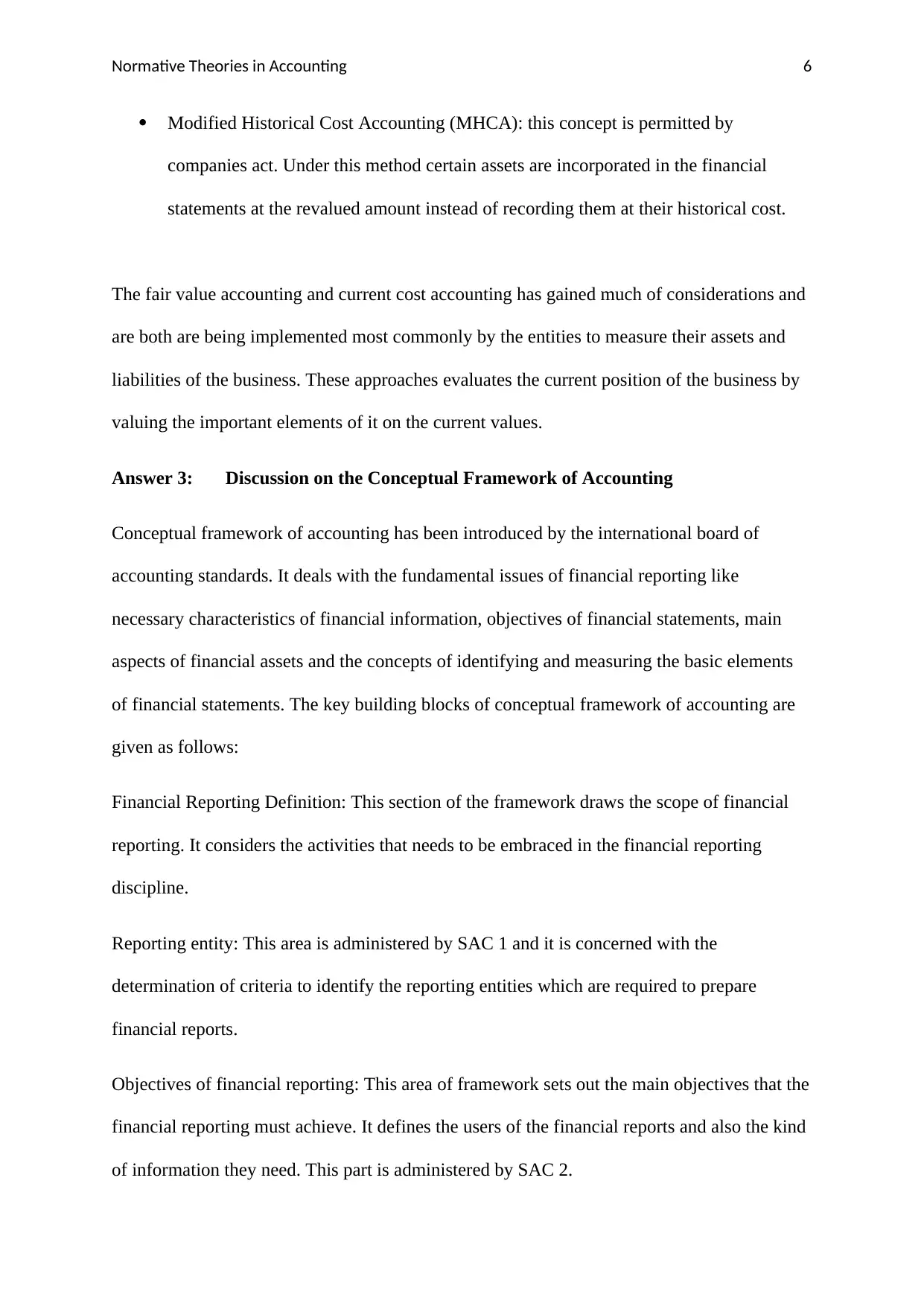
Normative Theories in Accounting 6
Modified Historical Cost Accounting (MHCA): this concept is permitted by
companies act. Under this method certain assets are incorporated in the financial
statements at the revalued amount instead of recording them at their historical cost.
The fair value accounting and current cost accounting has gained much of considerations and
are both are being implemented most commonly by the entities to measure their assets and
liabilities of the business. These approaches evaluates the current position of the business by
valuing the important elements of it on the current values.
Answer 3: Discussion on the Conceptual Framework of Accounting
Conceptual framework of accounting has been introduced by the international board of
accounting standards. It deals with the fundamental issues of financial reporting like
necessary characteristics of financial information, objectives of financial statements, main
aspects of financial assets and the concepts of identifying and measuring the basic elements
of financial statements. The key building blocks of conceptual framework of accounting are
given as follows:
Financial Reporting Definition: This section of the framework draws the scope of financial
reporting. It considers the activities that needs to be embraced in the financial reporting
discipline.
Reporting entity: This area is administered by SAC 1 and it is concerned with the
determination of criteria to identify the reporting entities which are required to prepare
financial reports.
Objectives of financial reporting: This area of framework sets out the main objectives that the
financial reporting must achieve. It defines the users of the financial reports and also the kind
of information they need. This part is administered by SAC 2.
Modified Historical Cost Accounting (MHCA): this concept is permitted by
companies act. Under this method certain assets are incorporated in the financial
statements at the revalued amount instead of recording them at their historical cost.
The fair value accounting and current cost accounting has gained much of considerations and
are both are being implemented most commonly by the entities to measure their assets and
liabilities of the business. These approaches evaluates the current position of the business by
valuing the important elements of it on the current values.
Answer 3: Discussion on the Conceptual Framework of Accounting
Conceptual framework of accounting has been introduced by the international board of
accounting standards. It deals with the fundamental issues of financial reporting like
necessary characteristics of financial information, objectives of financial statements, main
aspects of financial assets and the concepts of identifying and measuring the basic elements
of financial statements. The key building blocks of conceptual framework of accounting are
given as follows:
Financial Reporting Definition: This section of the framework draws the scope of financial
reporting. It considers the activities that needs to be embraced in the financial reporting
discipline.
Reporting entity: This area is administered by SAC 1 and it is concerned with the
determination of criteria to identify the reporting entities which are required to prepare
financial reports.
Objectives of financial reporting: This area of framework sets out the main objectives that the
financial reporting must achieve. It defines the users of the financial reports and also the kind
of information they need. This part is administered by SAC 2.
Paraphrase This Document
Need a fresh take? Get an instant paraphrase of this document with our AI Paraphraser
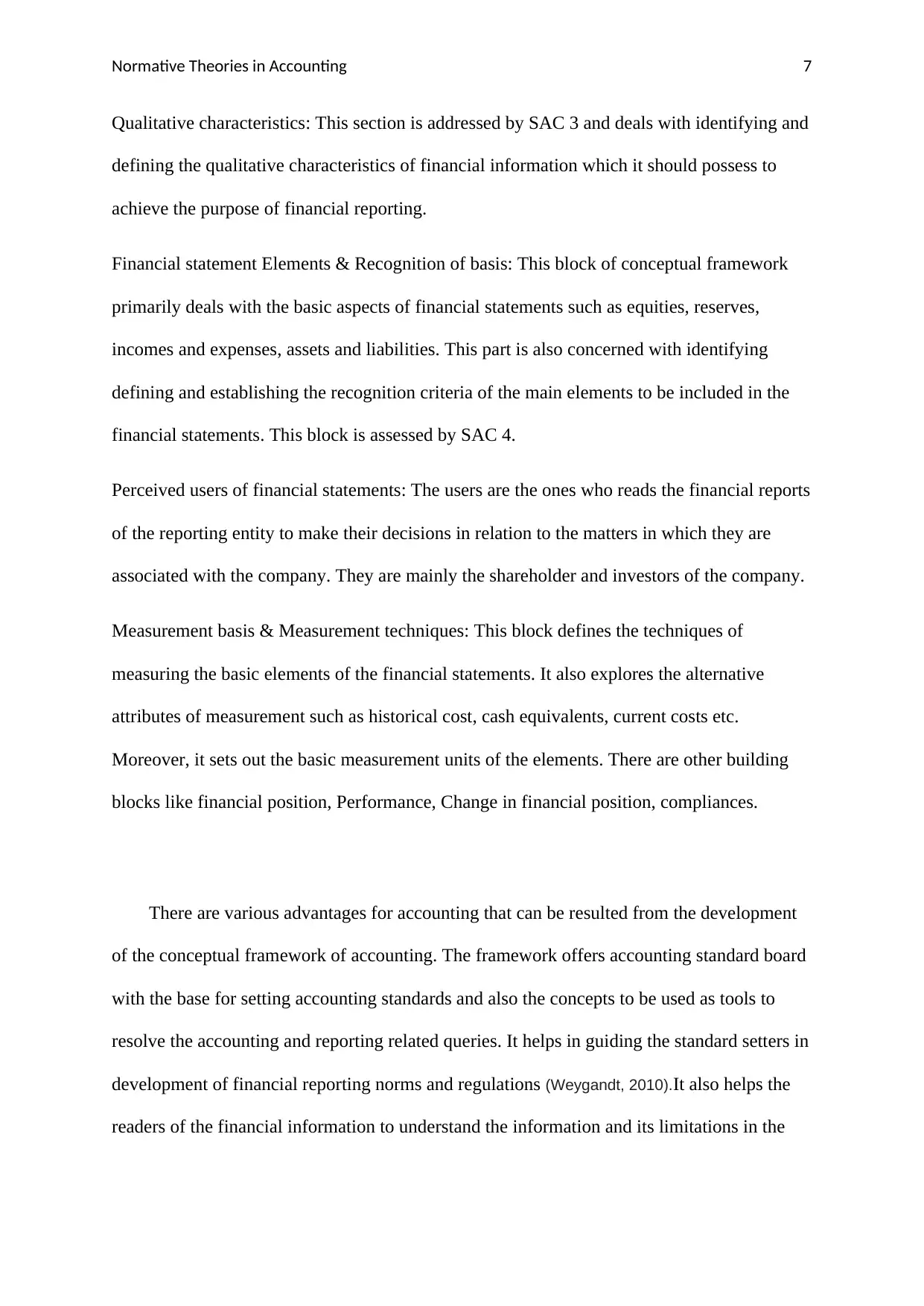
Normative Theories in Accounting 7
Qualitative characteristics: This section is addressed by SAC 3 and deals with identifying and
defining the qualitative characteristics of financial information which it should possess to
achieve the purpose of financial reporting.
Financial statement Elements & Recognition of basis: This block of conceptual framework
primarily deals with the basic aspects of financial statements such as equities, reserves,
incomes and expenses, assets and liabilities. This part is also concerned with identifying
defining and establishing the recognition criteria of the main elements to be included in the
financial statements. This block is assessed by SAC 4.
Perceived users of financial statements: The users are the ones who reads the financial reports
of the reporting entity to make their decisions in relation to the matters in which they are
associated with the company. They are mainly the shareholder and investors of the company.
Measurement basis & Measurement techniques: This block defines the techniques of
measuring the basic elements of the financial statements. It also explores the alternative
attributes of measurement such as historical cost, cash equivalents, current costs etc.
Moreover, it sets out the basic measurement units of the elements. There are other building
blocks like financial position, Performance, Change in financial position, compliances.
There are various advantages for accounting that can be resulted from the development
of the conceptual framework of accounting. The framework offers accounting standard board
with the base for setting accounting standards and also the concepts to be used as tools to
resolve the accounting and reporting related queries. It helps in guiding the standard setters in
development of financial reporting norms and regulations (Weygandt, 2010).It also helps the
readers of the financial information to understand the information and its limitations in the
Qualitative characteristics: This section is addressed by SAC 3 and deals with identifying and
defining the qualitative characteristics of financial information which it should possess to
achieve the purpose of financial reporting.
Financial statement Elements & Recognition of basis: This block of conceptual framework
primarily deals with the basic aspects of financial statements such as equities, reserves,
incomes and expenses, assets and liabilities. This part is also concerned with identifying
defining and establishing the recognition criteria of the main elements to be included in the
financial statements. This block is assessed by SAC 4.
Perceived users of financial statements: The users are the ones who reads the financial reports
of the reporting entity to make their decisions in relation to the matters in which they are
associated with the company. They are mainly the shareholder and investors of the company.
Measurement basis & Measurement techniques: This block defines the techniques of
measuring the basic elements of the financial statements. It also explores the alternative
attributes of measurement such as historical cost, cash equivalents, current costs etc.
Moreover, it sets out the basic measurement units of the elements. There are other building
blocks like financial position, Performance, Change in financial position, compliances.
There are various advantages for accounting that can be resulted from the development
of the conceptual framework of accounting. The framework offers accounting standard board
with the base for setting accounting standards and also the concepts to be used as tools to
resolve the accounting and reporting related queries. It helps in guiding the standard setters in
development of financial reporting norms and regulations (Weygandt, 2010).It also helps the
readers of the financial information to understand the information and its limitations in the
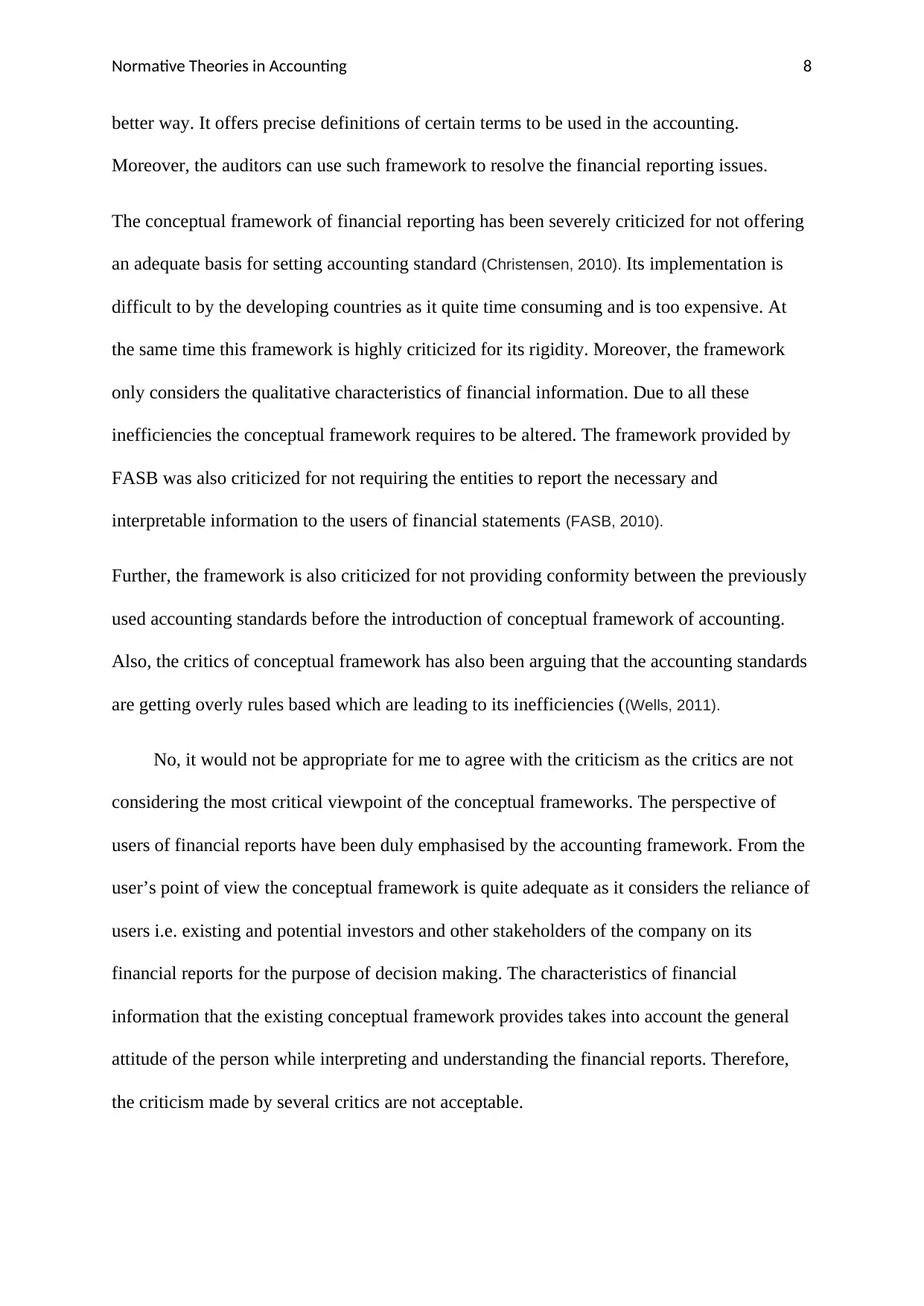
Normative Theories in Accounting 8
better way. It offers precise definitions of certain terms to be used in the accounting.
Moreover, the auditors can use such framework to resolve the financial reporting issues.
The conceptual framework of financial reporting has been severely criticized for not offering
an adequate basis for setting accounting standard (Christensen, 2010). Its implementation is
difficult to by the developing countries as it quite time consuming and is too expensive. At
the same time this framework is highly criticized for its rigidity. Moreover, the framework
only considers the qualitative characteristics of financial information. Due to all these
inefficiencies the conceptual framework requires to be altered. The framework provided by
FASB was also criticized for not requiring the entities to report the necessary and
interpretable information to the users of financial statements (FASB, 2010).
Further, the framework is also criticized for not providing conformity between the previously
used accounting standards before the introduction of conceptual framework of accounting.
Also, the critics of conceptual framework has also been arguing that the accounting standards
are getting overly rules based which are leading to its inefficiencies ((Wells, 2011).
No, it would not be appropriate for me to agree with the criticism as the critics are not
considering the most critical viewpoint of the conceptual frameworks. The perspective of
users of financial reports have been duly emphasised by the accounting framework. From the
user’s point of view the conceptual framework is quite adequate as it considers the reliance of
users i.e. existing and potential investors and other stakeholders of the company on its
financial reports for the purpose of decision making. The characteristics of financial
information that the existing conceptual framework provides takes into account the general
attitude of the person while interpreting and understanding the financial reports. Therefore,
the criticism made by several critics are not acceptable.
better way. It offers precise definitions of certain terms to be used in the accounting.
Moreover, the auditors can use such framework to resolve the financial reporting issues.
The conceptual framework of financial reporting has been severely criticized for not offering
an adequate basis for setting accounting standard (Christensen, 2010). Its implementation is
difficult to by the developing countries as it quite time consuming and is too expensive. At
the same time this framework is highly criticized for its rigidity. Moreover, the framework
only considers the qualitative characteristics of financial information. Due to all these
inefficiencies the conceptual framework requires to be altered. The framework provided by
FASB was also criticized for not requiring the entities to report the necessary and
interpretable information to the users of financial statements (FASB, 2010).
Further, the framework is also criticized for not providing conformity between the previously
used accounting standards before the introduction of conceptual framework of accounting.
Also, the critics of conceptual framework has also been arguing that the accounting standards
are getting overly rules based which are leading to its inefficiencies ((Wells, 2011).
No, it would not be appropriate for me to agree with the criticism as the critics are not
considering the most critical viewpoint of the conceptual frameworks. The perspective of
users of financial reports have been duly emphasised by the accounting framework. From the
user’s point of view the conceptual framework is quite adequate as it considers the reliance of
users i.e. existing and potential investors and other stakeholders of the company on its
financial reports for the purpose of decision making. The characteristics of financial
information that the existing conceptual framework provides takes into account the general
attitude of the person while interpreting and understanding the financial reports. Therefore,
the criticism made by several critics are not acceptable.
⊘ This is a preview!⊘
Do you want full access?
Subscribe today to unlock all pages.

Trusted by 1+ million students worldwide
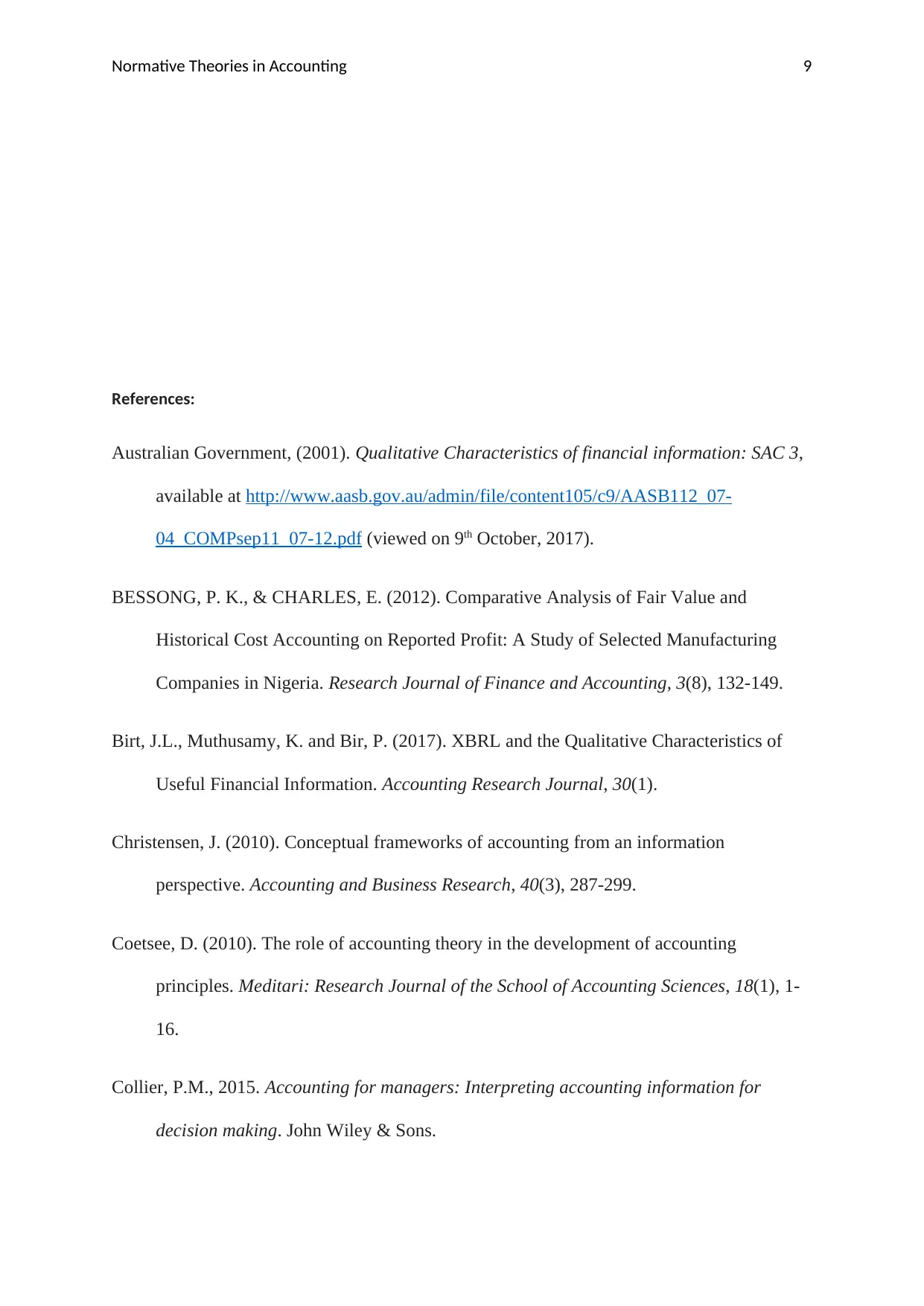
Normative Theories in Accounting 9
References:
Australian Government, (2001). Qualitative Characteristics of financial information: SAC 3,
available at http://www.aasb.gov.au/admin/file/content105/c9/AASB112_07-
04_COMPsep11_07-12.pdf (viewed on 9th October, 2017).
BESSONG, P. K., & CHARLES, E. (2012). Comparative Analysis of Fair Value and
Historical Cost Accounting on Reported Profit: A Study of Selected Manufacturing
Companies in Nigeria. Research Journal of Finance and Accounting, 3(8), 132-149.
Birt, J.L., Muthusamy, K. and Bir, P. (2017). XBRL and the Qualitative Characteristics of
Useful Financial Information. Accounting Research Journal, 30(1).
Christensen, J. (2010). Conceptual frameworks of accounting from an information
perspective. Accounting and Business Research, 40(3), 287-299.
Coetsee, D. (2010). The role of accounting theory in the development of accounting
principles. Meditari: Research Journal of the School of Accounting Sciences, 18(1), 1-
16.
Collier, P.M., 2015. Accounting for managers: Interpreting accounting information for
decision making. John Wiley & Sons.
References:
Australian Government, (2001). Qualitative Characteristics of financial information: SAC 3,
available at http://www.aasb.gov.au/admin/file/content105/c9/AASB112_07-
04_COMPsep11_07-12.pdf (viewed on 9th October, 2017).
BESSONG, P. K., & CHARLES, E. (2012). Comparative Analysis of Fair Value and
Historical Cost Accounting on Reported Profit: A Study of Selected Manufacturing
Companies in Nigeria. Research Journal of Finance and Accounting, 3(8), 132-149.
Birt, J.L., Muthusamy, K. and Bir, P. (2017). XBRL and the Qualitative Characteristics of
Useful Financial Information. Accounting Research Journal, 30(1).
Christensen, J. (2010). Conceptual frameworks of accounting from an information
perspective. Accounting and Business Research, 40(3), 287-299.
Coetsee, D. (2010). The role of accounting theory in the development of accounting
principles. Meditari: Research Journal of the School of Accounting Sciences, 18(1), 1-
16.
Collier, P.M., 2015. Accounting for managers: Interpreting accounting information for
decision making. John Wiley & Sons.
Paraphrase This Document
Need a fresh take? Get an instant paraphrase of this document with our AI Paraphraser
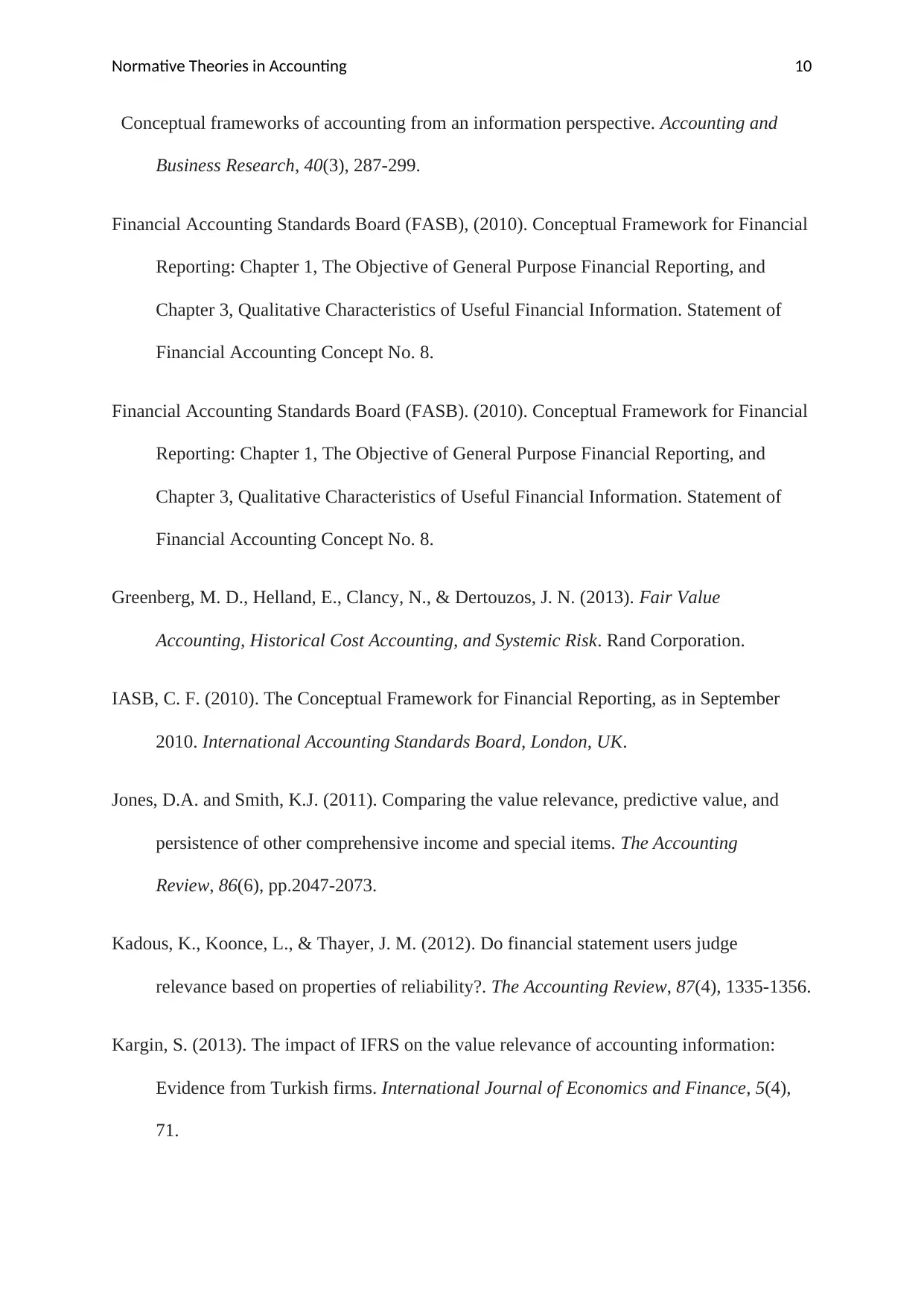
Normative Theories in Accounting 10
Conceptual frameworks of accounting from an information perspective. Accounting and
Business Research, 40(3), 287-299.
Financial Accounting Standards Board (FASB), (2010). Conceptual Framework for Financial
Reporting: Chapter 1, The Objective of General Purpose Financial Reporting, and
Chapter 3, Qualitative Characteristics of Useful Financial Information. Statement of
Financial Accounting Concept No. 8.
Financial Accounting Standards Board (FASB). (2010). Conceptual Framework for Financial
Reporting: Chapter 1, The Objective of General Purpose Financial Reporting, and
Chapter 3, Qualitative Characteristics of Useful Financial Information. Statement of
Financial Accounting Concept No. 8.
Greenberg, M. D., Helland, E., Clancy, N., & Dertouzos, J. N. (2013). Fair Value
Accounting, Historical Cost Accounting, and Systemic Risk. Rand Corporation.
IASB, C. F. (2010). The Conceptual Framework for Financial Reporting, as in September
2010. International Accounting Standards Board, London, UK.
Jones, D.A. and Smith, K.J. (2011). Comparing the value relevance, predictive value, and
persistence of other comprehensive income and special items. The Accounting
Review, 86(6), pp.2047-2073.
Kadous, K., Koonce, L., & Thayer, J. M. (2012). Do financial statement users judge
relevance based on properties of reliability?. The Accounting Review, 87(4), 1335-1356.
Kargin, S. (2013). The impact of IFRS on the value relevance of accounting information:
Evidence from Turkish firms. International Journal of Economics and Finance, 5(4),
71.
Conceptual frameworks of accounting from an information perspective. Accounting and
Business Research, 40(3), 287-299.
Financial Accounting Standards Board (FASB), (2010). Conceptual Framework for Financial
Reporting: Chapter 1, The Objective of General Purpose Financial Reporting, and
Chapter 3, Qualitative Characteristics of Useful Financial Information. Statement of
Financial Accounting Concept No. 8.
Financial Accounting Standards Board (FASB). (2010). Conceptual Framework for Financial
Reporting: Chapter 1, The Objective of General Purpose Financial Reporting, and
Chapter 3, Qualitative Characteristics of Useful Financial Information. Statement of
Financial Accounting Concept No. 8.
Greenberg, M. D., Helland, E., Clancy, N., & Dertouzos, J. N. (2013). Fair Value
Accounting, Historical Cost Accounting, and Systemic Risk. Rand Corporation.
IASB, C. F. (2010). The Conceptual Framework for Financial Reporting, as in September
2010. International Accounting Standards Board, London, UK.
Jones, D.A. and Smith, K.J. (2011). Comparing the value relevance, predictive value, and
persistence of other comprehensive income and special items. The Accounting
Review, 86(6), pp.2047-2073.
Kadous, K., Koonce, L., & Thayer, J. M. (2012). Do financial statement users judge
relevance based on properties of reliability?. The Accounting Review, 87(4), 1335-1356.
Kargin, S. (2013). The impact of IFRS on the value relevance of accounting information:
Evidence from Turkish firms. International Journal of Economics and Finance, 5(4),
71.
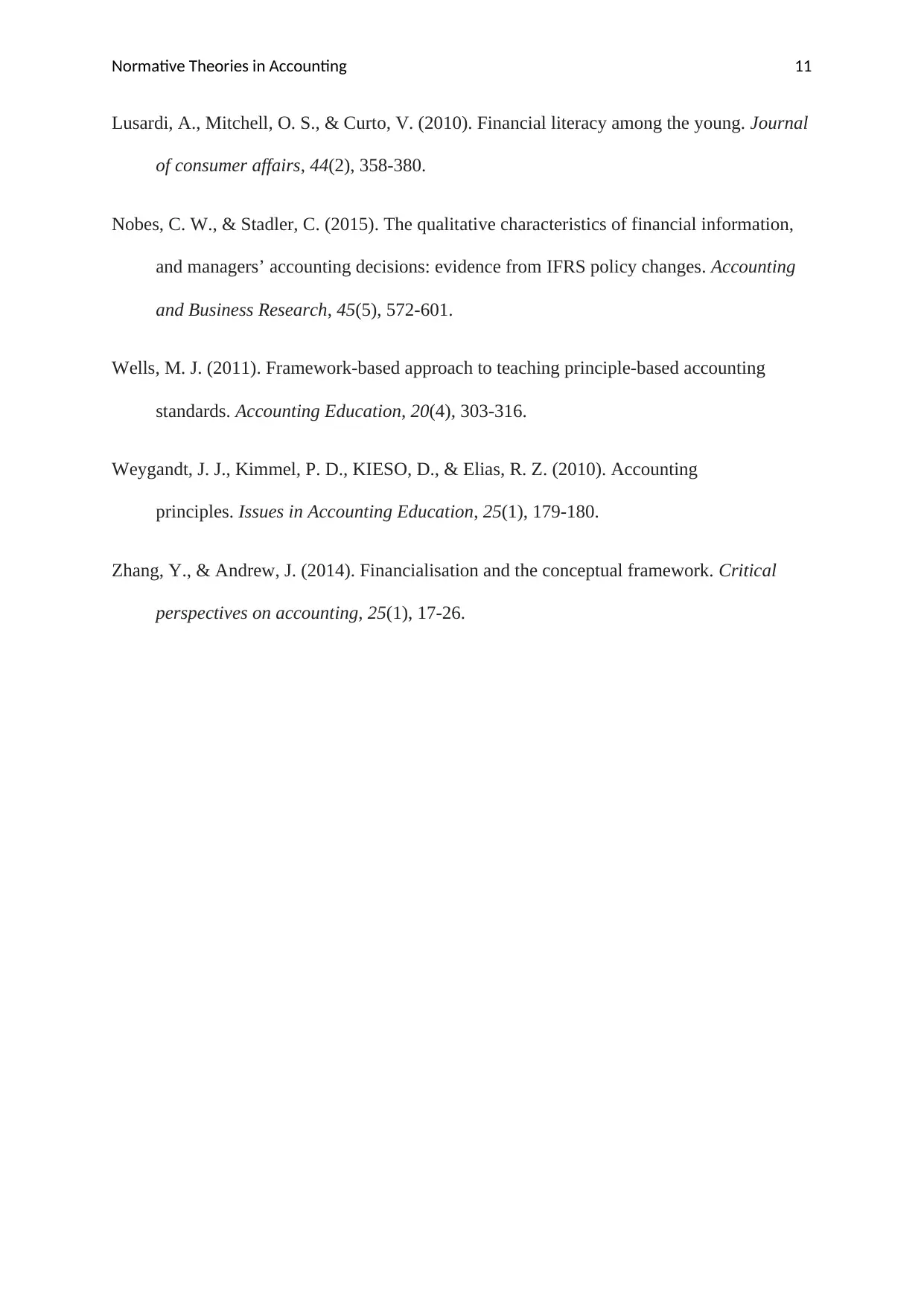
Normative Theories in Accounting 11
Lusardi, A., Mitchell, O. S., & Curto, V. (2010). Financial literacy among the young. Journal
of consumer affairs, 44(2), 358-380.
Nobes, C. W., & Stadler, C. (2015). The qualitative characteristics of financial information,
and managers’ accounting decisions: evidence from IFRS policy changes. Accounting
and Business Research, 45(5), 572-601.
Wells, M. J. (2011). Framework-based approach to teaching principle-based accounting
standards. Accounting Education, 20(4), 303-316.
Weygandt, J. J., Kimmel, P. D., KIESO, D., & Elias, R. Z. (2010). Accounting
principles. Issues in Accounting Education, 25(1), 179-180.
Zhang, Y., & Andrew, J. (2014). Financialisation and the conceptual framework. Critical
perspectives on accounting, 25(1), 17-26.
Lusardi, A., Mitchell, O. S., & Curto, V. (2010). Financial literacy among the young. Journal
of consumer affairs, 44(2), 358-380.
Nobes, C. W., & Stadler, C. (2015). The qualitative characteristics of financial information,
and managers’ accounting decisions: evidence from IFRS policy changes. Accounting
and Business Research, 45(5), 572-601.
Wells, M. J. (2011). Framework-based approach to teaching principle-based accounting
standards. Accounting Education, 20(4), 303-316.
Weygandt, J. J., Kimmel, P. D., KIESO, D., & Elias, R. Z. (2010). Accounting
principles. Issues in Accounting Education, 25(1), 179-180.
Zhang, Y., & Andrew, J. (2014). Financialisation and the conceptual framework. Critical
perspectives on accounting, 25(1), 17-26.
⊘ This is a preview!⊘
Do you want full access?
Subscribe today to unlock all pages.

Trusted by 1+ million students worldwide
1 out of 12
Related Documents
Your All-in-One AI-Powered Toolkit for Academic Success.
+13062052269
info@desklib.com
Available 24*7 on WhatsApp / Email
![[object Object]](/_next/static/media/star-bottom.7253800d.svg)
Unlock your academic potential
Copyright © 2020–2025 A2Z Services. All Rights Reserved. Developed and managed by ZUCOL.





